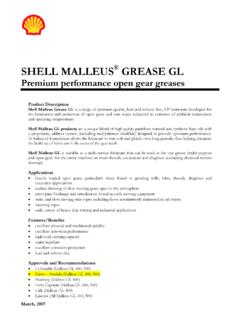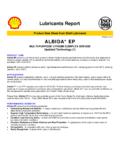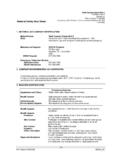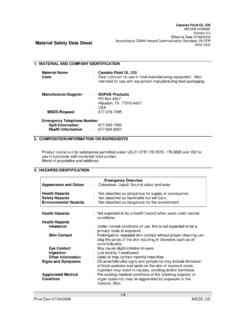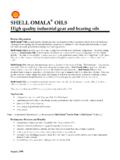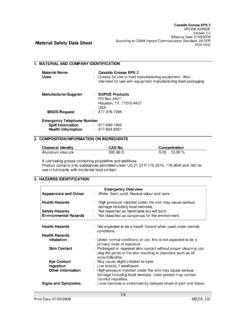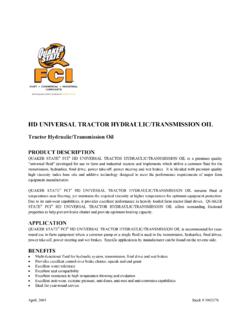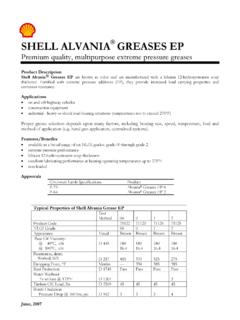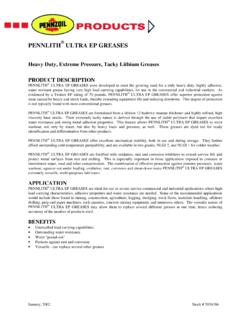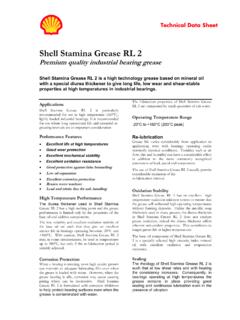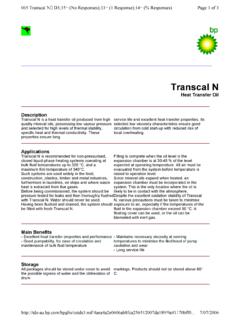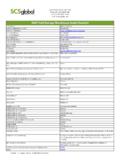Transcription of Effective Date 07/02/2008 Material Safety Data …
1 Cassida Fluid GL 460. MSDS# 402169L. Version Effective Date 07/02/2008 . According to OSHA Hazard Communication Standard, 29 CFR. Material Safety Data Sheet 1. Material AND COMPANY IDENTIFICATION. Material Name : Cassida Fluid GL 460. Uses : Gear lubricant for use in food manufacturing equipment. Also intended for use with equipment manufacturing food packaging. Manufacturer/Supplier : SOPUS Products PO Box 4427. Houston, TX 77210-4427. USA. MSDS Request : 877-276-7285. Emergency Telephone Number Spill Information : 877-242-7400.
2 Health Information : 877-504-9351. 2. COMPOSITION/INFORMATION ON INGREDIENTS. Product contains only substances permitted under US 21 CFR , and 182 for use in lubricants with incidental food contact. Blend of polyolefins and additives. Product contains only substances permitted under US 21 CFR , and 182 for use in lubricants with incidental food contact. 3. HAZARDS IDENTIFICATION. Emergency Overview Appearance and Odour : Colourless. Liquid. Neutral odour and taste. Health Hazards : Not classified as dangerous for supply or conveyance.
3 Safety Hazards : Not classified as flammable but will burn. Environmental Hazards : Not classified as dangerous for the environment. Health Hazards : Not expected to be a health hazard when used under normal conditions. Health Hazards Inhalation : Under normal conditions of use, this is not expected to be a primary route of exposure. Skin Contact : Prolonged or repeated skin contact without proper cleaning can clog the pores of the skin resulting in disorders such as oil acne/folliculitis. Eye Contact : May cause slight irritation to eyes.
4 Ingestion : Low toxicity if swallowed. Other Information : Used oil may contain harmful impurities. Signs and Symptoms : Oil acne/folliculitis signs and symptoms may include formation of black pustules and spots on the skin of exposed areas. Ingestion may result in nausea, vomiting and/or diarrhoea. Aggravated Medical : Pre-existing medical conditions of the following organ(s) or 1/8. Print Date 07/09/2008 MSDS_US. Cassida Fluid GL 460. MSDS# 402169L. Version Effective Date 07/02/2008 . According to OSHA Hazard Communication Standard, 29 CFR.
5 Material Safety Data Sheet Condition organ system(s) may be aggravated by exposure to this Material : Skin. Environmental Hazards : Not classified as dangerous for the environment. Additional Information : Under normal conditions of use or in a foreseeable emergency, this product does not meet the definition of a hazardous chemical when evaluated according to the OSHA Hazard Communication Standard, 29 CFR 4. FIRST AID MEASURES. General Information : Not expected to be a health hazard when used under normal conditions.
6 Inhalation : No treatment necessary under normal conditions of use. If symptoms persist, obtain medical advice. Skin Contact : Remove contaminated clothing. Flush exposed area with water and follow by washing with soap if available. If persistent irritation occurs, obtain medical attention. Eye Contact : Flush eye with copious quantities of water. If persistent irritation occurs, obtain medical attention. Ingestion : In general no treatment is necessary unless large quantities are swallowed, however, get medical advice.
7 Advice to Physician : Treat symptomatically. 5. FIRE FIGHTING MEASURES. Clear fire area of all non-emergency personnel. Flash point : Typical 274 C / 525 F (COC). Upper / lower : Typical 1 - 10 %(V). Flammability or Explosion limits Auto ignition temperature : > 320 C / 608 F. Specific Hazards : Hazardous combustion products may include: A complex mixture of airborne solid and liquid particulates and gases (smoke). Carbon monoxide. Unidentified organic and inorganic compounds. Suitable Extinguishing : Foam, water spray or fog.
8 Dry chemical powder, carbon Media dioxide, sand or earth may be used for small fires only. Unsuitable Extinguishing : Do not use water in a jet. Media Protective Equipment for : Proper protective equipment including breathing apparatus Firefighters must be worn when approaching a fire in a confined space. 6. ACCIDENTAL RELEASE MEASURES. Avoid contact with spilled or released Material . For guidance on selection of personal protective equipment see Chapter 8 of this Material Safety Data Sheet. See Chapter 13 for information on disposal.
9 Observe all relevant local and international regulations. Protective measures : Avoid contact with skin and eyes. Use appropriate containment to avoid environmental contamination. Prevent from spreading or entering drains, ditches or rivers by using sand, earth, or 2/8. Print Date 07/09/2008 MSDS_US. Cassida Fluid GL 460. MSDS# 402169L. Version Effective Date 07/02/2008 . According to OSHA Hazard Communication Standard, 29 CFR. Material Safety Data Sheet other appropriate barriers. Clean Up Methods : Slippery when spilt.
10 Avoid accidents, clean up immediately. Prevent from spreading by making a barrier with sand, earth or other containment Material . Reclaim liquid directly or in an absorbent. Soak up residue with an absorbent such as clay, sand or other suitable Material and dispose of properly. Additional Advice : Local authorities should be advised if significant spillages cannot be contained. 7. HANDLING AND STORAGE. General Precautions : Use local exhaust ventilation if there is risk of inhalation of vapours, mists or aerosols.
